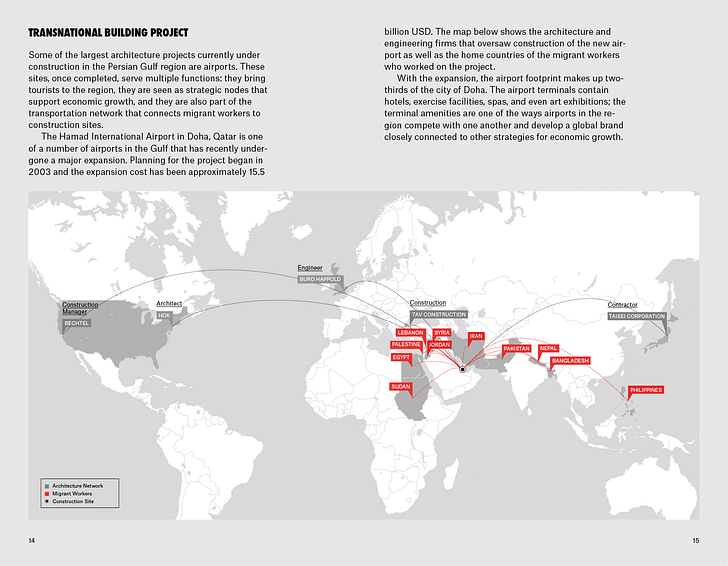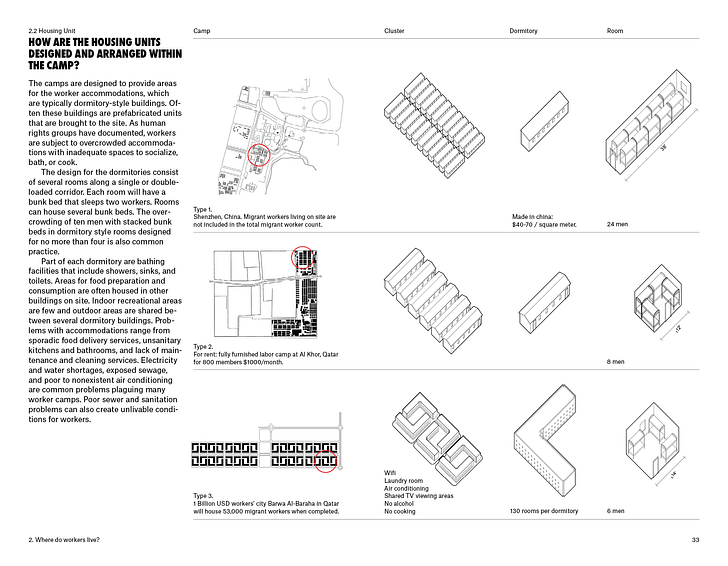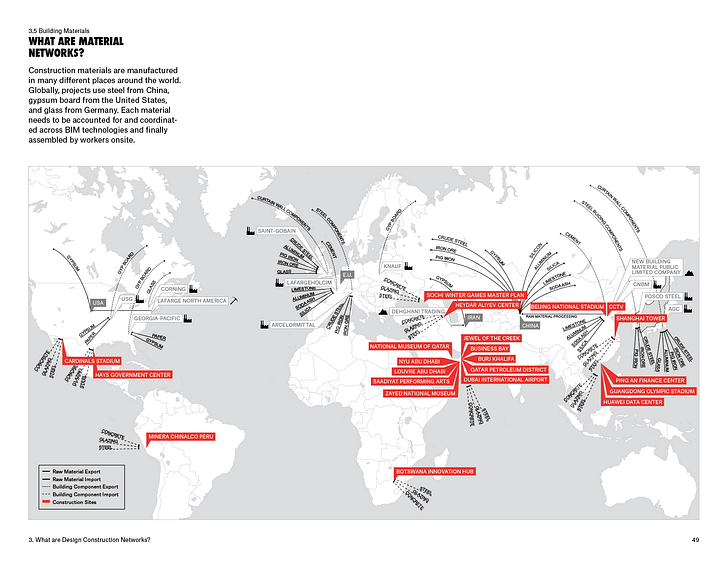

Who Builds Your Architecture? (WBYA?) asks architects and allied fields to better understand how the production of buildings connects their design and consulting practices to the workers who ultimately build them. As a primer, the WBYA? Critical Field Guide introduces key terms, questions, case studies, and proposals that locate architecture within the complex transnational networks of contemporary building construction and connects it to the problems faced by construction workers who exist within the same system. It aims to shift the focus from how buildings are conceived by architects to how they are materialized by a broad network of people including architects, construction workers, and a host of other actors.
The Critical Field Guide employs the representational tools and techniques of architecture along with critical analysis to explain and make legible architecture’s entanglements with the vast geopolitical and economic structures of contemporary building construction. The WBYA? Critical Field Guide offers proposals for best practices, ideas for action, and resources for more in-depth study on the many issues and challenges affecting workers worldwide.

Global Networks of Construction Workers and Architects
Global capitalism has expanded the scope and scale of the building industry to form an expansive supply chain—a vast network of manufacturers, suppliers, and builders whose operations are aided by digital technologies and facilitated by transportation systems connecting most regions of the world. It employs an array of actors linked via legal and professional relationships—architects, construction managers, engineers, contractors, consultants, clients, financiers, and construction workers. This has led to the atomization and dispersion of fields related to the design and construction of buildings, and the proliferation of contracts and agreements that bind them together.
Migrant construction workers often face unscrupulous conduct by recruitment firms, subcontractors, and local authorities
Since the 1970s, the liberalization of economies has propelled the movement of capital and labor to new markets around the world. These globalized connections of production have spawned economic lifelines, as families and home nations depend upon the remittances sent back by legions of migrant workers. As the number of workers seeking employment in other parts of the world has increased exponentially, so has their exploitation and abuse through predatory recruitment networks and unsavory employers seeking to maximize profit by reducing wages and expanding work hours. The construction industry has taken advantage of these labor trends by contracting seasonal and short-term workforces from abroad—a labor procurement practice ideal for the one-time-only, site-specific nature of building projects. Migrant construction workers often face unscrupulous conduct by recruitment firms, subcontractors, and local authorities—each jockeying to extract a bigger cut of the workers’ salaries.


Persistent problems with the recruitment process include exorbitant fees exacted from workers to secure a position abroad, as well as fraudulent representation of the type of work and level of compensation. On poorly managed job sites, migrant workers can be repeatedly exposed to dangerous working conditions. Construction companies and subcontractors seeking to limit expenditures often house thousands of men in poorly maintained, substandard accommodation that lacks basic amenities for food preparation and delivery, proper hygiene, and reliable climate control in regions with scorching temperatures. The human rights organization Amnesty International reported a case in Qatar, for example, where workers were required to sleep in shifts due to scarce accommodations. With “worker camps” often built outside the city limits, migrant construction workers—shut out of the public spaces that architects and urban theorists claim are vital to a robust urban life—are isolated from the civic and social spheres of local residents. Since migrant workers are not citizens of the nations in which they work, they have very few rights and avenues of recourse to protest their poor treatment. Under the threat of deportation if they violate any of the stringent rules, most workers choose to remain and continue to work.how can architects be most effective in bettering the conditions of workers employed in building their designs?
At the other end of the construction industry supply chain, architects are hired not just for their creativity and design capabilities—whose visually compelling designs are celebrated in the media—but also in the service role of interpreting and executing a project within a framework established by a client’s needs and desires. At the same time, international-scale projects, often presented as cultural centerpieces for cities or nations, garner international prestige by exploiting the image of the celebrity architect and thus provide a platform for architects to expand their role beyond form-maker, problem-solver, and service provider.

Advocacy and Action
WBYA? asks how can architects be most effective in bettering the conditions of workers employed in building their designs? Many points of pressure are needed to effect change in the various networks that coordinate the actors and resources in building these large-scale projects. Architects cannot shoulder this responsibility alone, or resolve the professional and ethical challenges that arise from these immense projects; it will require efforts from all parties within these networks. Labor unions and human rights organizations have become key allies of constructions workers to resolve issues with owners and governments. Some solutions will also rest within the purview of the architect’s expertise in housing and urban design and should become part of the international debate on these issues. The WBYA? Critical Field Guide offers an introduction to the issues and an outline for possible actions to this critical global problem.

Find out more about who builds your architecture and read the full field guide here.
No Comments
Block this user
Are you sure you want to block this user and hide all related comments throughout the site?
Archinect
This is your first comment on Archinect. Your comment will be visible once approved.